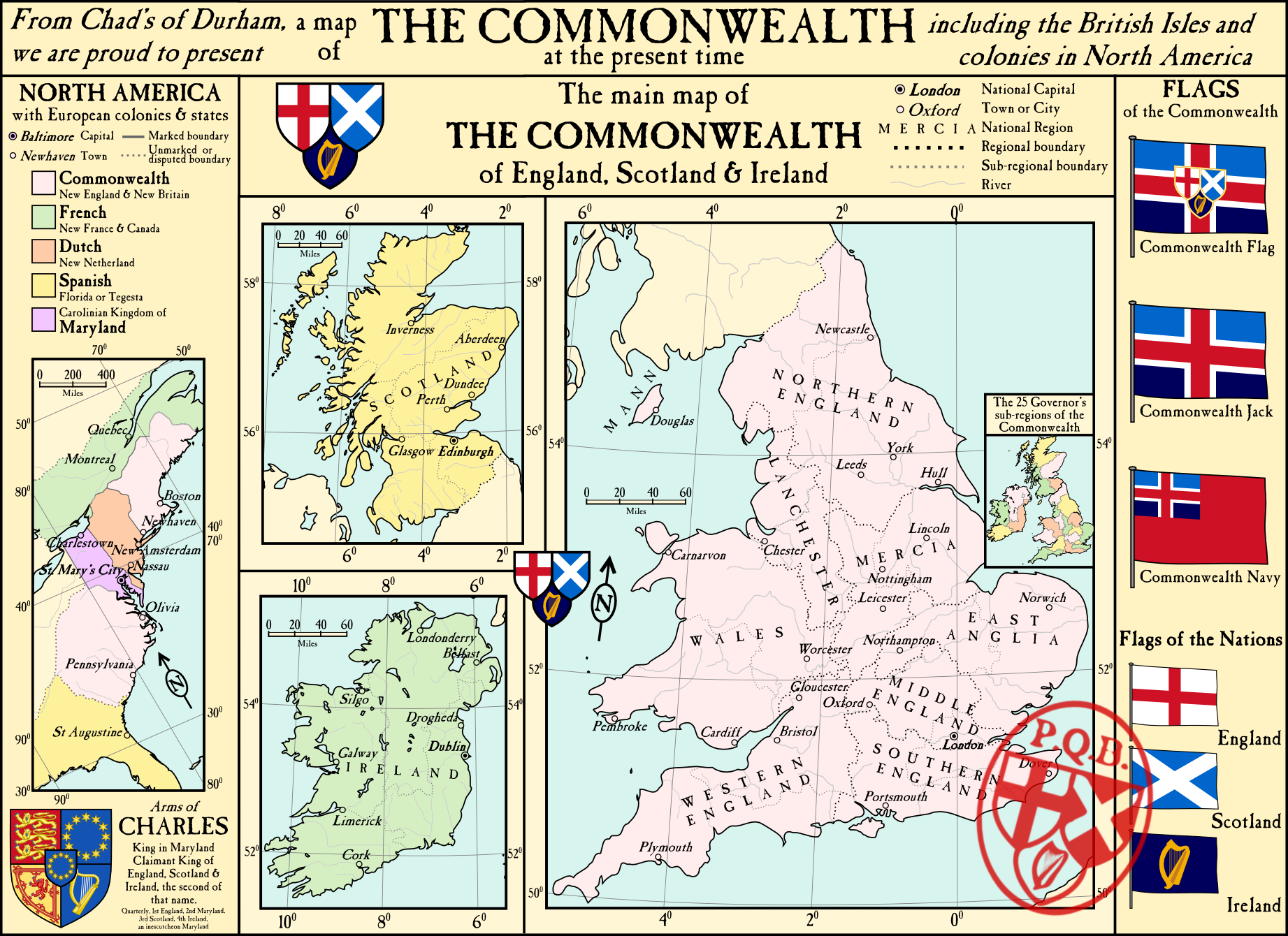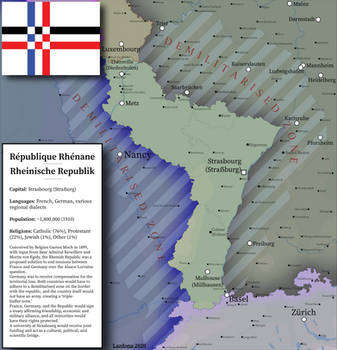ShopDreamUp AI ArtDreamUp
Deviation Actions
Suggested Deviants
Suggested Collections
You Might Like…
Featured in Groups
Description
My entry for MotF 47: A surviving Commonwealth after Cromwell lives 10 years more.
-----------------------------------
One cannot help but wonder, that if Cromwell had lived a longer life, whether the monarchy would have ever been restored. Had he lived ten more years the populous may have been so used to a Republic the idea of having a king again may have been repugnant. [link]
The PoD is Oliver Cromwell not dying in 1658, but instead living for another 10 years. He still suffers from the bout of malarial fever and septicemia, but with better doctors he manages to pull through. His close call is seen by him as a warning from God that the Commonwealth is as fragile as he is, and that he must "...do all to stabalise it and insure it's continuation, so that [the Commonwealth] may continue in freedom as I watch it from above in the Lord's company".
In those 10 years Cromwell, along with his son Richard and advisers, begin to reform the Commonwealth. Similar to the rule of the Major-generals, the nation (including Scotland and Ireland) is split up into 11 regions, each with a leader nominated by Cromwell (almost entirely military men) to sit in the Council of State. This time however each region was split onto sub-regions, 2 from each of the 8 English regions (making 16), 1 from the Isle of Man, and 4 from both Scotland and Ireland; this created the 25 member Upper House for the new Commonwealth, the House of Governors. The Governors were in theory "elected", but they were usually local men nominated by local city leaders, councils etc. Below them was the 500-man Commonwealth Parliament.
The other great leap forward was in the still-existing Commonwealth colonies in North America. Cromwell continued to believe in the Western Design, despite the not entirely great success in the Anglo-Spanish War. Instead he focused on the settling of the existing colonies in North America, all but one (Maryland) declared their strong support for the Commonwealth. Maryland was a mainly Catholic province, and it's Governor, Lord Baltimore, had created in effect the last place English Catholics could be safe from persecution. This situation was tolerated but stretched to breaking point as the English courts exiled more and more Catholics to the colony, and it expanded further north along the border with the Dutch colony. Maryland soon became the most populated province in the whole continent, mainly full of people who's loyalty to the Commonwealth was "low" at best. What happened next was not entirely unexpected.
The American Revolution (or American Restoration as it was sometimes known) had a clear starting point, the emergence of the exiled Charles II from a Dutch trading ship in the port of New Amsterdam, 1667. With some assistance form the Dutch, who lost the First Anglo-Dutch War in 1652 against Cromwell's Navy, and who were also worried about the growing Anglo-French ties), Charles had managed to sneak into Maryland where, sheltered by Lord Baltimore, he proclaimed himself King in Maryland and of England, Scotland and Ireland in exile. The Catholics in the province provided a large support base, and it was soon clear when the news reached London months later that there was little the Commonwealth could do.
Cromwell had forbidden any major military build up in the colonies, still unsure of the situation at home and wary of the fact that many of the best Generals from the New Model Army were important members of one of the three sections of the government. As such the Commonwealth response to the announcement was only to send an emissary to St Mary's City to check on the accuracy of the claim and to repeal the charter from the colony if true. By the time he got there the Carolinian Kingdom of Maryland had had over 6 months to prepare themselves, along with arms supplied subtly by French supporters and less subtly by the Dutch and Spanish. Even Cromwell realised mounting a military campaign over the Atlantic was near impossible, especially with the possibility (that they had made quite clear) of Spanish and Dutch support for the Kingdom and French neutrality. Instead in his speech, delivered to the Commonwealth Parliament in July 1668, and one of his last, he made clear his position that "it is better that he is over there than over here, indeed he seems to have saved us the trouble of exiling himself there". Although unpopular, the Commonwealth reached a settlement on the borders of the Kingdom, the first independent European state in the new world, and that it must be neutral in all European affairs. Charles, and his descendants, would continue to claim the kingdoms of England, Scotland and Ireland.
This map shows the Commonwealth and North America in around about 1700, the Charles mentioned is Charles II of Maryland, III of England, Scotland and Ireland.
-----------------------------------
One cannot help but wonder, that if Cromwell had lived a longer life, whether the monarchy would have ever been restored. Had he lived ten more years the populous may have been so used to a Republic the idea of having a king again may have been repugnant. [link]
The PoD is Oliver Cromwell not dying in 1658, but instead living for another 10 years. He still suffers from the bout of malarial fever and septicemia, but with better doctors he manages to pull through. His close call is seen by him as a warning from God that the Commonwealth is as fragile as he is, and that he must "...do all to stabalise it and insure it's continuation, so that [the Commonwealth] may continue in freedom as I watch it from above in the Lord's company".
In those 10 years Cromwell, along with his son Richard and advisers, begin to reform the Commonwealth. Similar to the rule of the Major-generals, the nation (including Scotland and Ireland) is split up into 11 regions, each with a leader nominated by Cromwell (almost entirely military men) to sit in the Council of State. This time however each region was split onto sub-regions, 2 from each of the 8 English regions (making 16), 1 from the Isle of Man, and 4 from both Scotland and Ireland; this created the 25 member Upper House for the new Commonwealth, the House of Governors. The Governors were in theory "elected", but they were usually local men nominated by local city leaders, councils etc. Below them was the 500-man Commonwealth Parliament.
The other great leap forward was in the still-existing Commonwealth colonies in North America. Cromwell continued to believe in the Western Design, despite the not entirely great success in the Anglo-Spanish War. Instead he focused on the settling of the existing colonies in North America, all but one (Maryland) declared their strong support for the Commonwealth. Maryland was a mainly Catholic province, and it's Governor, Lord Baltimore, had created in effect the last place English Catholics could be safe from persecution. This situation was tolerated but stretched to breaking point as the English courts exiled more and more Catholics to the colony, and it expanded further north along the border with the Dutch colony. Maryland soon became the most populated province in the whole continent, mainly full of people who's loyalty to the Commonwealth was "low" at best. What happened next was not entirely unexpected.
The American Revolution (or American Restoration as it was sometimes known) had a clear starting point, the emergence of the exiled Charles II from a Dutch trading ship in the port of New Amsterdam, 1667. With some assistance form the Dutch, who lost the First Anglo-Dutch War in 1652 against Cromwell's Navy, and who were also worried about the growing Anglo-French ties), Charles had managed to sneak into Maryland where, sheltered by Lord Baltimore, he proclaimed himself King in Maryland and of England, Scotland and Ireland in exile. The Catholics in the province provided a large support base, and it was soon clear when the news reached London months later that there was little the Commonwealth could do.
Cromwell had forbidden any major military build up in the colonies, still unsure of the situation at home and wary of the fact that many of the best Generals from the New Model Army were important members of one of the three sections of the government. As such the Commonwealth response to the announcement was only to send an emissary to St Mary's City to check on the accuracy of the claim and to repeal the charter from the colony if true. By the time he got there the Carolinian Kingdom of Maryland had had over 6 months to prepare themselves, along with arms supplied subtly by French supporters and less subtly by the Dutch and Spanish. Even Cromwell realised mounting a military campaign over the Atlantic was near impossible, especially with the possibility (that they had made quite clear) of Spanish and Dutch support for the Kingdom and French neutrality. Instead in his speech, delivered to the Commonwealth Parliament in July 1668, and one of his last, he made clear his position that "it is better that he is over there than over here, indeed he seems to have saved us the trouble of exiling himself there". Although unpopular, the Commonwealth reached a settlement on the borders of the Kingdom, the first independent European state in the new world, and that it must be neutral in all European affairs. Charles, and his descendants, would continue to claim the kingdoms of England, Scotland and Ireland.
This map shows the Commonwealth and North America in around about 1700, the Charles mentioned is Charles II of Maryland, III of England, Scotland and Ireland.
Image size
1843x1340px 1.09 MB
© 2011 - 2024 Martin23230
Comments29
Join the community to add your comment. Already a deviant? Log In
Whats PQD?



































